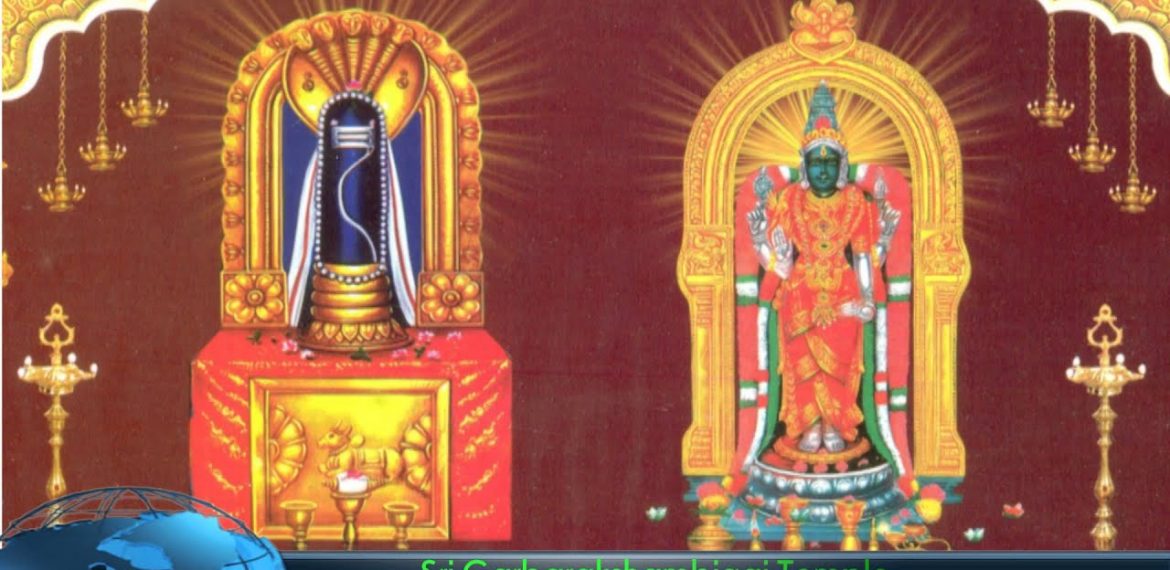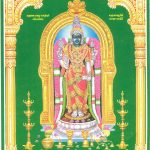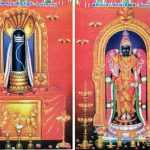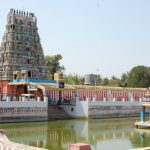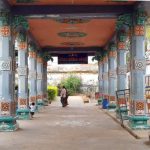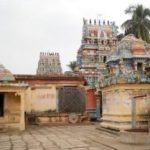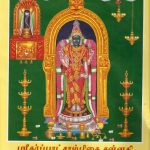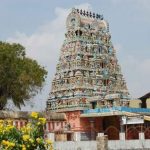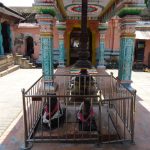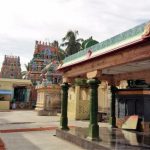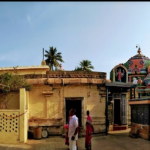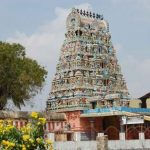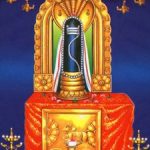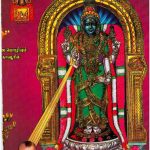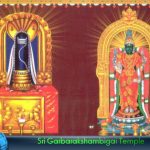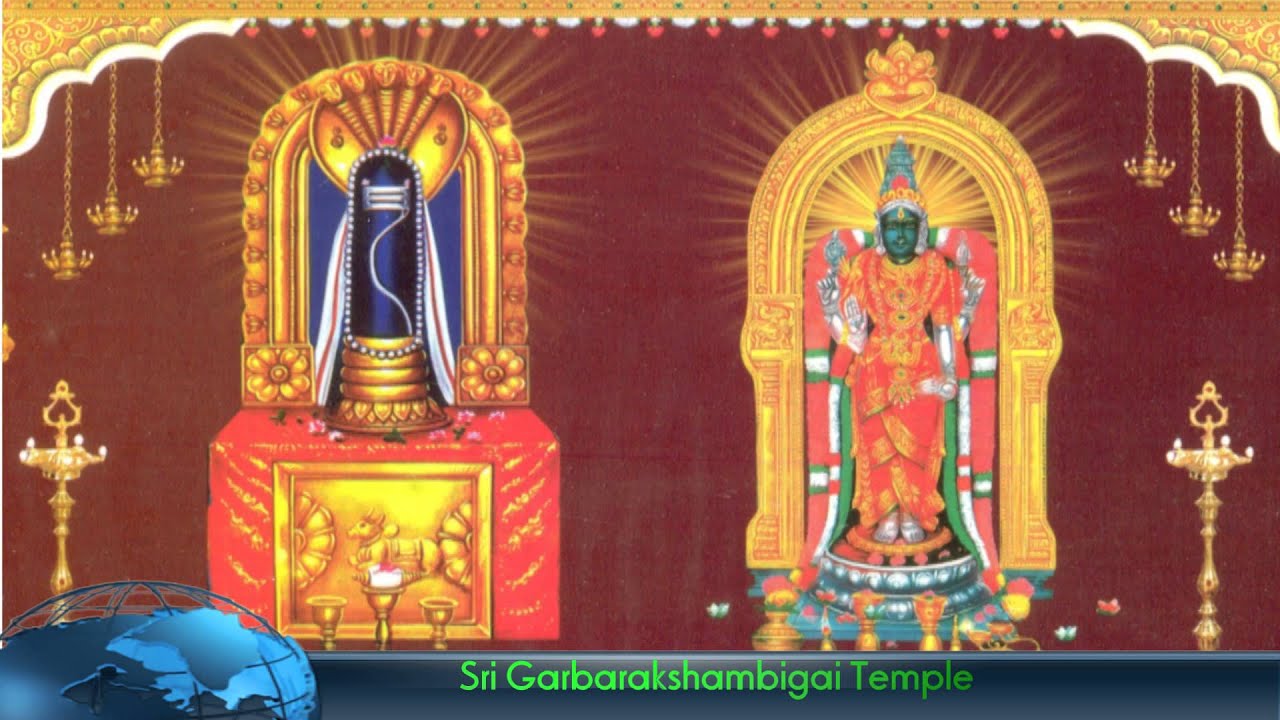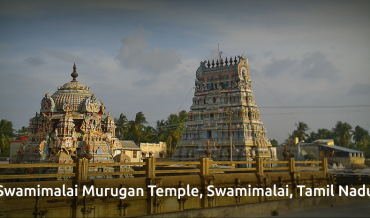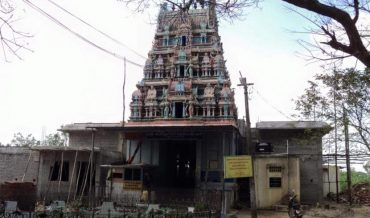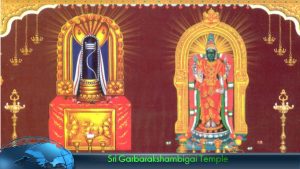
Main Deity
Sri Garbharakshambigai Temple is located in the small village called Thirukarukavur which is located at fertile land of Thanjavur (Tanjore Dist.) Tamil Nadu.
Sthala Vriksham: Mullai creeper (Mullai means Jasmine in Tamil)
Why should you offer prayers to Garbarakshambigai Amman (Devi)?
First – Let’s know the meaning of Garbharakshambigai Amman –
Garbha+Raksha+Ambigai (Garbha means Womb, Raksha means who protects, Ambigai means Devi’s name)
Garbharakshambika means “The Mother Who Protects the Womb”.
Sri Garbharakshambigai Temple – For Childless and Pregnant Women
Garbarakshambigai Amman is the foremost fertility Devi of India. She is renowned for her powers to bless couples with children and also safeguard pregnancies and ensure an easy delivery. Here Devi has the powers to bless every aspect of childbearing.
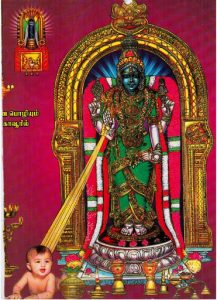
Child bless
It is believed that childless people who worship here with Bhakthi and Shraddha are blessed with a pregnancy and pregnant women with safe deliveries. Unmarried women also pray here for their marriages. Special prayers are conducted by people on behalf of their pregnant relatives or friends.
Origin of the Temple:
Let’s Imagine a moment or event thousands of years ago, a time when Rishi’s and Muni’s populated India and miracles abounded.
The sleepy village of Thirukarukavur was enclosed by a thick forest where Gautama Maharishi and Markandeya Maharishi carried on their tapas. During this time Mahadev Shiva manifested as a Swayambu Lingam. The Lingam appeared with a Jasmine Creeper entwined around it. This aspect of Shiva was then called Mulaivananathar.
Mulai means Jasmine and Vananathar means Bhagwan of the Jasmine garden.
Mahadev Mulaivanathar grants the boon of good health. People suffering from skin diseases and other incurable conditions offer prayers here and take the punugu sattam prasadam to get relief from their sufferings.
Devi Parvati took the form of Garbarakshambigai Amman to grant a boon to all childless devotees who wanted the blessings of having children. A temple was built at the place where the swayambu Lingam manifested and was called the Garbarakshambigai Temple or also as the Mahadev Mulaivananathar Temple
Thousands of childless devotees throng this temple every day to pray for the blessings of conceiving children and pregnant women come here to pray for a safe pregnancy and easy delivery.
The significance of The Temple:
A majestic and magnificent form of Shakti, Devi Garbharakshambika is responsible for granting the boon of motherhood to childless women, protecting women with uterus related disorders, and protecting the unborn babies of pregnant women.
Thousands of devotees across all regions, sects and religions visit the temple everyday to pay homage to Her.
Who should offer prayers at the Garbarakshambigai Amman?
- Childless people trying to conceive
- Pregnant women who want a safe pregnancy and easy delivery
- Unmarried women also pray here for their marriages
Who should offer prayers to Mahadev Mulaivananathar?
- People with incurable diseases
- People with skin disorders
- People who wants good health
The uniform experience of the people of these parts bears unfailing testimony to the powers of the deities of this Temple. The inhabitants of the village vouch for the fact, that within living memory, there has been no case of fatality to the mother or child during confinement.
Pregnant women from elsewhere come here and pray to Devi & Mahadev for a safe childbirth. No one in this place has ever had a miscarriage or pregnancy problem. It is at a place like this that one can understand what “Divine Presence” is.
Sattology of Garbarakshambigai Amman
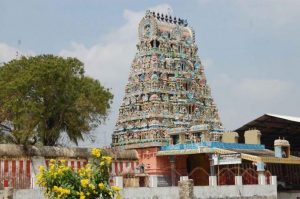
sri-mullaivananathar-sri-garbarakshambigai-amman-temple
Garbarakshambigai Amman is the foremost fertility Goddess of India. She is renowned for her powers to bless couples with children and also safeguard pregnancies and ensure easy delivery. In short she has the powers to bless every aspect of childbearing.
For over a thousand years Sages like Appar, Sundarar and Campantar have recited the glories of this Amman as early as the 7th century in the 12 volume Saiva canonical works. Other literary works like the Periya Puranam by Sezhkizhar also mention the glory of this temple and the Amman here.
The story of Garbarakshambigai Amman dates back to the ages when sages lived and performed tapas in forests. In a place called Mullai Vanam (Jasmine Garden), Gouthama Maharishi and Gargeya Maharishi lived in an ashram. They were served by a couple by the name of Nidhruva and Vedikai. This couple had no children and were prayed to the sages to guide them and Vedikai had a great urge to become a mother. The sages then instructed the couple to perform puja and worship Devi Parvathi in the form of Garbarakshambigai Amman. Their prayers were soon answered and Vedikai soon conceived a child.
One day Nidhruva left to visit Varuna Deva by traveling through the skies. Rishis in those days had many powers. Vedhika was in the third trimester of her pregnancy. One day Sage Urdhvapada visited the Ashram seeking alms. Vedhika was alone in the ashram and since she was in an advanced state of pregnancy and very tired after the daily household chores, she was lying down and taking rest. Vedhika didn’t notice the Rishi or hear him, therefore, she failed to respond and unwittingly failed to offer due hospitality to the guest. Urdhvapada felt terribly insulted and unaware of her pregnancy got incensed at her conduct and cursed her for not paying due respects to him. He cursed that she should suffer from a disease called “Rayatchu”, as a result of which poor Vedhika was struck with a foul disease, which began to eat into the very vitals of not only herself but also the child in her womb.
She was devastated and prayed to Garbarakshambiai Amman again. Garbarakshambigai Amman appeared before Vedikai and took the foetus, placing in inside a pot. This foetus developed into a male child and the devoted couple were very happy parents. The child was named Naidhuruvan.
Because of this benevolent act, inmates of the ashram led by Vedikai prayed to Devi to remain in that place i.e. the Mullai Vanam (today the place is called Thrirukarukavur) and offer her grace and protection to all women who want to conceive and also those who are already pregnant. Devi accepting their prayers and remain there as the protector of the wombs of women.
The grace of Amman did not end there. She also provided milk to the child Naidhruvan by sending the divine cow Kamadhenu. When Kamadhenu came down to provide milk to the child the hooves of the cow that were planted in front of the temple gave rise to a spring of water which formed a tank. The tank is called Kshreeakundam and exists even today.
Since that time in Sattology this Amman has become the Devi who blesses all women who pray to her for children.
Devi Garbarakshambika’s Moorthi is the supreme personality of Motherhood and this is represented by the magnificent 7 feet tall Moorthi.
This moorthi stands in the sanctum sanctorum (Garba Graha) of Her temple. This beautiful idol is adorned with kanjeevaram sarees and exquisite jewellery. She is decked with abundant fragrant and colorful flowers which add to Her beauty. The Devi has the most radiant smile on Her face depicting positivity and a ray of hope.
For the thousands who throng to Her abode, She is not just a moorthi, She is their only remaining hope. Even a casual visitor cannot fail to be thrilled by the motherly grace and the imposing look of the Goddess here.
Mahadev Mulaivana Nathar:

MVN
Mahadev Shiva is mainly worshiped in the form of a Shiva Linga. In the Shiva lingam, one can see even today the impression of jasmine creepers which once covered the Shiva lingam.
The place has been a forest with jasmine garden once upon a time. Hence the Shiva at this place is called as Mullaivana Nathar (God of the Jasmine Garden). The Shiva Lingam of the presiding deity, Mahadev Mullaivana Nathar in the main sanctum of this temple is a Swayambu (self-manifested ) Lingam, it is one out of the 64 in the world.
Mullai (Jasmine flower) also known as Madhvi or Vasanti in Sanskrit, is the favorite flower of this deity.
The Lingam of Mahadev Mullaivana Nathar is made up of ant hill mud. Therefore there is no water abhisekam for Mahadev here. Instead, the Lingam is merely smeared with a kind of musk called “Punugu” in Tamil.
It is said that worshiping the main deity Mahadev Mullaivana Nathar will cure all kinds of skin diseases. People who are afflicted with incurable diseases come to this temple, offer “Punugu Chattam” to Mahadev and get themselves relieved of their diseases
The Temple Atmosphere:
The temple has a peaceful atmosphere and has not really changed much over the last 200 years.
You can see the photograph from the early 1800’s and compare it to the photo taken in 2013 and see that the architecture remains more or less the same. Temple gardens that contribute to the peaceful atmosphere.
Temple Architecture
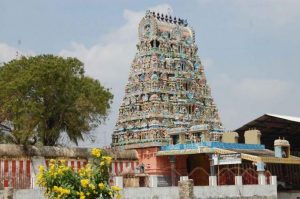
sri-mullaivananathar-sri-garbarakshambigai-amman-temple
Shri Garbharakshambika Sameta Shri Mullaivana Nathar temple is spread over a wide expanse with huge Gopurams and a beautiful water tank in front of it.
There is a main Raja Gopuram on the east and the temple has also got an entrance on the south side. The temple is surrounded by tall coconut palms, the whole atmosphere is very calm and serene and lends the place sanctity.
Once you walk past the temple tank, you reach into the temple complex of Shri Garbharakshambika Sameta Shri Mullaivana Nathar. Both the shrines of Mahadev Mullaivana Nathar and Devi Garbharakshambika are situated in the outer Praharam, which is the main Praharam facing the East direction.
The main sanctum of this temple has the Shiva lingam and Devi Garbharakshambika is situated to the left of the Shiva temple.
It is believed that the Nandi at this temple is in Swayambhu vigraha (Self-manifested) and so is the Karpaga Vinayagar inside the temple and as such commands unique devotion from the worshipers.
There is also a shrine for Bhagwan Subrahmania.
The devotees first visit the shrine of Mahadev Mulaivananathar and then the shrine of Devi Garbarakshambigai.
Garbarakshambigai Temple History:
The Gopuram and the huge compound walls tell the story of more than a thousand years.
The Sthala puranas which are in Sanskrit and Tamil are preserved in manuscript forms and show the antiquity of the temple. The Sthala purana gives a detailed account of the origin of this Kshetra and the various persons who obtained Divine Grace at this place. There are also ancient inscriptions on the walls inside.
Inscriptions from King Raja Raja Chola’s period who ruled between 985 and 1014 AD; as well as those from Parantaka Chola’s period (early 10th century AD) are seen inside the temple. There is evidence that Bheema, Garkiyar, Gouthama Maharishi and a lot of ancient kings worshiped Mahadev in this temple.
Appar, Sundarar and Sambandar, the three famous Nayan-mars (Sages or Mahadev Bhakths) have celebrated the glory of Mahadev and this temple in soul-stirring verses (pathigams) of rare beauty and charm. The three Nayanmars visited these temples along with their followers in spite of the inconveniences they faced while traveling the nook and corner of Tamilnadu in search of these temples.
There are instances when Mahadev Shiva himself had directed them and shown the way to some of the temples so that the above Nayanmars could visit these temples and compose Pathigams. These Pathigams composed in the classical Tamil language are of immense value to Tamil literature.
How to reach this Temple – Location from Google maps – Click Here
Reference: Temple website: http://garbarakshambigai.org/
Gallery:
- garbarakshambigai-Amman
- garbarakshambigai-eswaran
- Garbarakshambigai-Temple
- garbarakshambigai-temple1
- garbarakshambigai-temple
- GarbhaRakshambigai
- sri-mullaivananathar-sri-garbarakshambigai-amman-temple
- temple-enterance
- View from inside mullaivana
- Panoramic View of Temple
- sri-mullaivananathar-sri-garbarakshambigai-amman-temple
- MVN
- Child bless
- Main Deity
Images Source: Google, Flickr, Sri. Arun Prasad & Sri. Satish
Here is the small video clip to have a better understanding about Garbharakshambigai Temple. Request to go thru the original YouTube video, which includes subtitles in English for better understanding.
All information entered is personal to the author. Any modification or changes must be addressed to the author.

